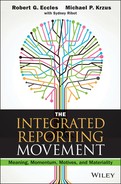Appendix 6A
Comparing the Ford and Daimler Materiality Matrices
While the 3 × 3 matrix displayed on Ford's website on December 30, 2013 (Figure 6A.1), is similar in structure to its first public effort in 2005, changes are evident. The number of issues in the matrix increased from 34 to 61, issue definitions have become more detailed and elaborate, issue trends from previous materiality analyses are noted, and the matrix has increased interactivity.1 The High Impact, High Concern issues in the top right-hand corner of the matrix are included in the company's printed summary report, the issues in the three adjacent boxes are reported on the web, and those in the remaining five boxes are not covered in detail through any type of reporting. The website has an “interactive” feature whereby the user can click on a box to see which issues it contains.2 The High Impact, High Concern box shows 14 issues in seven categories (Figure 6A.1) and for each issue, the user can scroll down to see a definition/description, comments, trend analysis, and hyperlinks to other pages on Ford's website that provide a more detailed discussion and information on Ford's strategy in relation to the issue.3

Figure 6A.1 Ford's Materiality Matrix
Source: Ford. Sustainability 2011/12, Our Blueprint for Sustainability, Overview of the Analysis Process, http://corporate.ford.com/microsites/sustainability-report-2012-13/blueprint-materiality-analysis, accessed December 2013.
Without going into great detail, Ford provides a reasonably clear view of how it developed its 2012/2013 matrix. The company defines “material information” as “that which is of greatest interest to, and which has the potential to affect the perception of, those stakeholders who wish to make informed decisions and judgments about the Company's commitment to environmental, social and economic progress.”4 It also emphasizes, “materiality as used in this Sustainability Report does not share the meaning of the concept for the purposes of financial reporting.”5
Ford provides a general description of how issues are identified and ranked for both the company and stakeholder axes with no supporting analytical detail. For the company axis, Ford notes the frequency with which issues are raised in its policies, business strategy, and performance tracking tools, and the Annual Report or Form 10-K. Ford does not explicitly say how it defines “current or potential impact” on the X-axis, but it does note that it considers “possible impacts and importance out to 10 years.”6 For the stakeholder dimension, Ford analyzes summaries of stakeholder engagement sessions as well as documents representing broader stakeholder views.7 The company does not explain how this analysis was aggregated into a single stakeholder dimension, but it does note that extra weight was assigned to “investors and multi-stakeholder inputs, as they are the key audiences of our reporting.”8
A Ceres Stakeholder Committee that included representatives of nongovernmental organization (NGOs), socially responsible investment organizations, and a supplier company reviewed Ford's analysis. On Ford's website, the company reported the Committee's detailed recommendations and noted what type of data assurance, if any, had been done on each issue.9
Table 6A.1 Ford's High Impact, High Concern Issues
Source: Ford. Sustainability 2011/12, Our Blueprint for Sustainability, Overview of the Analysis Process, http://corporate.ford.com/microsites/sustainability-report-2012-13/blueprint-materiality-analysis, accessed December 2013.
| 14 material issues have been identified at this level |
| SUSTAINABILITY VISION AND MANAGEMENT |
| Sustainability vision, governance, and management |
| PUBLIC POLICY |
| GHG/fuel economy regulation |
| GOVERNANCE |
| Human rights strategy |
| CLIMATE CHANGE |
| Low-carbon strategy |
| Vehicle GHG emissions |
| Electrification strategy |
| WATER |
| Water strategy – local community impacts |
| Water strategy – water impacts of products |
| Water strategy – water impacts of operations |
| OPERATIONS |
| Environmental management |
| SUPPLY CHAIN SUSTAINABILITY |
| Human rights in the supply chain |
| Supplier relationships |
| Sustainable raw materials |
| Supply chain environmental sustainability |
Ford's competitor, Daimler, also produced a materiality matrix (Figure 6A.2) for its 2012 “Sustainability Report.”10 Like Ford, Daimler updates the matrix every two years and indicates the degree of assurance provided on various issues. Compared to Ford, Daimler reversed the X-axis (determined through stakeholder engagement) and Y-axis (determined through the company's Sustainability Office and Board Sustainability Committee). Rather than using boxes to separate issues, the Daimler matrix only presents issues that score between “High” and “Very high” along each axis.11 Daimler's matrix also contains no interactive features. Both companies are similar in that they use documents and stakeholder engagement to identify and weight issues, although Daimler provides more detail on the process—as on the stakeholder axis, starting with an annual “Daimler Stakeholder Dialogue” held in Stuttgart, Germany, and organized into different working groups by topic (e.g., environmental protection and human rights).12

Figure 6A.2 Daimler's Materiality Matrix
Source: Daimler. Sustainability Report 2012.
In its 2011 Sustainability Report, Daimler includes a materiality analysis process chart (Figure 6A.3) showing the process by which their matrix is constructed. Daimler also conducted its first online survey, which “was open for all interested stakeholders to participate in online at daimler.com during a four-week period between November 15 and December 14, 2012.”13 Some 700 responses were received. Like Ford, Daimler attaches greater weight to some stakeholder groups (e.g., shareholders, customers, suppliers, employees, and NGOs) than others (which are not named).14 However, also like Ford, no analytical detail is provided about how these weightings resulted in issue placement on the Y-axis.

Figure 6A.3 Daimler Materiality Matrix Construction Process
Source: Daimler. Sustainability Report 2011.
